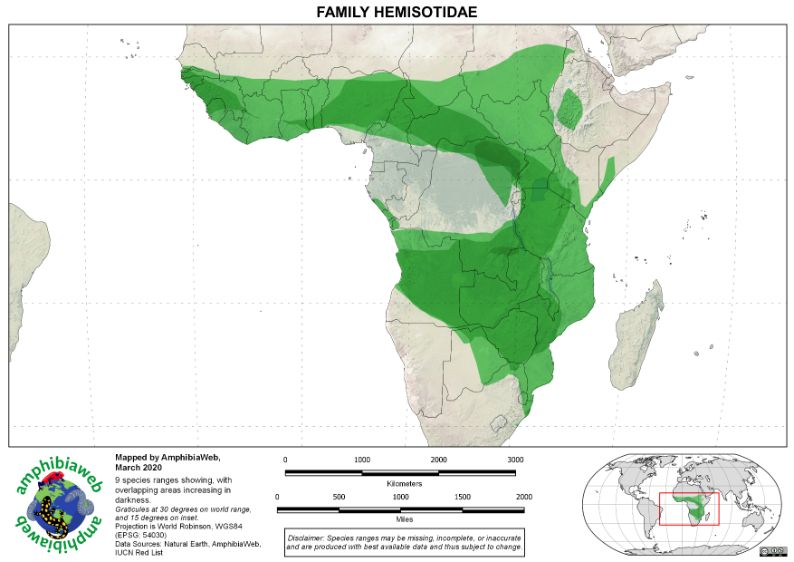Hemisotidae |
9 species in 1 genus
Commonly Called Shovel-nosed Frogs, Pig-nosed Frogs

Hemisus marmoratus
Photo by Robert C. Drewes
(Click for family gallery)The family Hemisotidae is made up of shovel-nosed, globose-bodied frogs within a single genus, Hemisus. Their hard-pointed snouts, strong forelimbs and hindlimbs, and loss of a sternum (convergent in Rhinophrynus) allow these frogs to be quick and efficient headfirst burrowers in tropical savanna of sub-Saharan Africa. They lay eggs underground in the plains near the end of the dry season. Nests are flooded and tadpoles then swim to temporary pools of water to finish their development. Tadpoles also wriggle onto the parent's backs to be transported to water.
Written by AmphibiaWebNotable Family Characteristics
- Inhabits tropical savannah, open plains
- Inguinal amplexus
- Parental care in the form of transporting tadpoles to pools after hatching
- Morphological features include: 1) hard-pointed snouts; 2) strong forelimbs and hindlimbs; 3) absence of sternum; 4) hardened skulls, which allow for head-first burrowing
- Distribution limited to sub-Saharan Africa

Cartography Credit: Zoe Yoo, UC Berkeley
Range maps sources: AmphibiaWeb, UC Berkeley, and IUCN RedListRelevant Reference
Pough, F. H., R. M. Andrews, M. L. Crump, A. H. Savitzky, K. D. Wells, and M. C. Brandley. 2015. Herpetology. Fourth Edition. Massachusetts: Sinauer.
Vitt, L. J., and J. P. Caldwell. 2013. Herpetology. An Introductory Biology of Amphibians and Reptiles. Fourth Edition. Amsterdam: Elsevier.
Genus Hemisus (9 species)
Hemisus barotseensis no account no photos no sound/video Hemisus brachydactylus no account no photos no sound/video Hemisus guineensis no account no photos no sound/video Hemisus guttatus account photos no sound/video Hemisus marmoratus account photos sound/video Hemisus microscaphus no account no photos no sound/video Hemisus olivaceus account no photos no sound/video Hemisus perreti no account no photos no sound/video Hemisus wittei no account no photos no sound/video
Citation: AmphibiaWeb: Information on amphibian biology and conservation. [web application]. Berkeley, California: AmphibiaWeb. Available: https://amphibiaweb.org/. (Accessed:
AmphibiaWeb's policy on data use.
